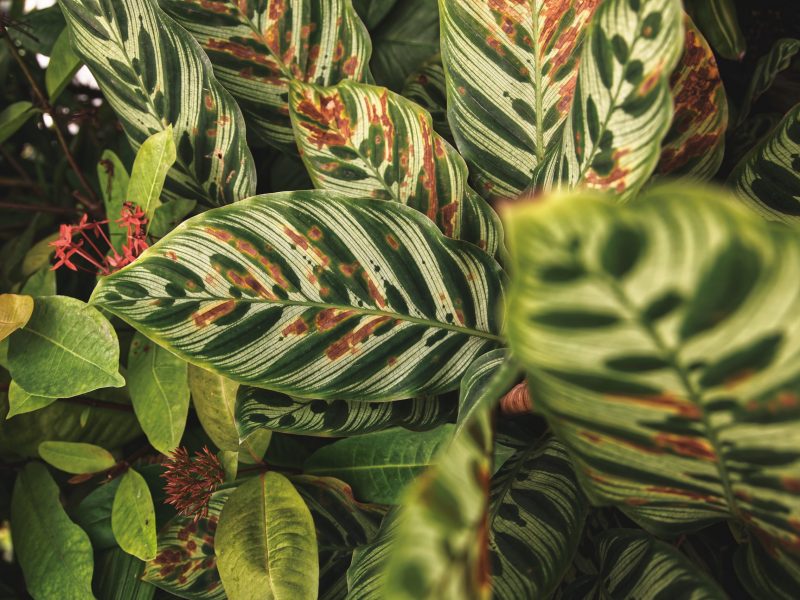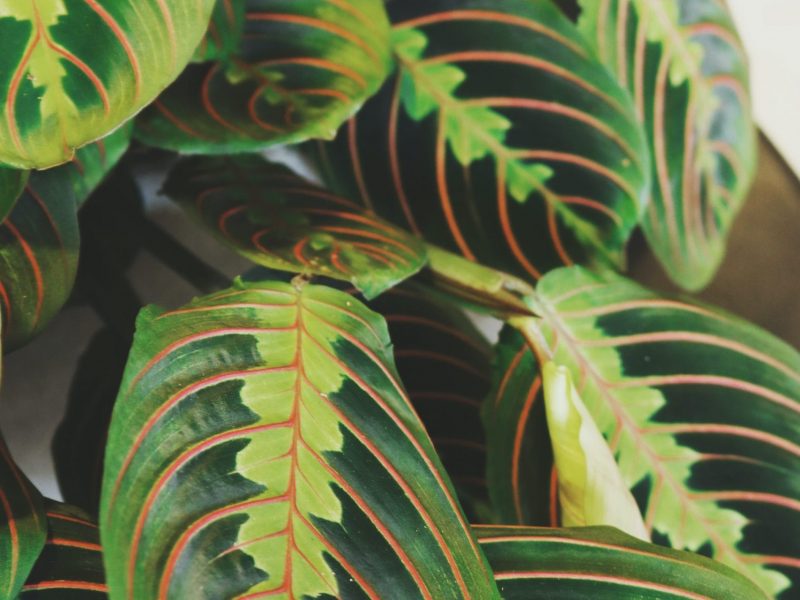
Prayer Plants are known for the beautiful pattered leaves and get their name from their unique feature of closing up like praying hands during the night. Prayer Plants tend to be pretty easy to care for but if you notice some of the leaves turning brown, it is a sign that something is wrong. There aren’t too many reasons why your Prayer Plant might be developing brown spots, the most common reasons are; watering issues, dry air, too much sunlight, chemicals in the water or a pest infestation.
Dry air can cause brown leaf tips on your Prayer Plant
If the soil isn’t particularly dry, it could be a lack of humidity that is causing your Prayer Plant’s leaves to turn brown. Prayer Plants like quite humid environments and can struggle in homes with dry air. This can be especially damaging in winter months when we often have the heating on for several hours a day. A lack of humidity in the air can cause the leaves to be a little limp and droop down as well as turn brown. There are several ways you can increase the humidity for your Prayer Plant:
Misting the leaves
One of the simplest ways to increase the humidity for your houseplants is to mist them with a spray bottle a couple of times a week. This will go a long way to avoiding any more brown leaves developing on your Prayer Plant.
Pebble tray
Place your houseplants over a tray of pebbles with fresh water over the top. Over the day water from the tray will evaporate giving the plants above exactly what they’re looking for.
Give your Prayer Plant a shower
To quickly raise the humidity and wash down your Prayer Plant of any long-standing dust, you can always give them a quick shower. Simply pop them in the shower and wash them down with lukewarm water (keeping the water pressure fairly low so you don’t damage the leaves) this will clean off the leaves and give the soil a good soaking.
Move your Prayer Plant to the bathroom
If you’re lucky enough to have great lighting in your bathroom you can move your Prayer Plant in there to increase the humidity. The running water from your showers means your bathroom is probably one of the most humid in your home which means it’ll naturally help to stop brown leaves.
Buy a humidifier
They’re relatively affordable little devices and they make keeping a consistent humidity level so much easier. Most will allow you to place them on a timer so they run on a fixed schedule, and some will even have a built-in monitor so they automatically turn on and off to keep the humidity exactly where you want it.
Want to know more about how to raise the humidity for your Prayer Plant and other houseplants? We have written a whole guide on this.
Overwatering can also cause brown leaves on your Prayer Plant
Too much water can also cause your Prayer Plant to develop brown leaves and this can be quite a worrying cause as it can damage the plant quite quickly. But instead of the leaves being light brown and crispy, they are soft and darker brown. Check your Prayer Plant’s soil straight away to see if it is waterlogged. If it is, then replace it with fresh potting mix to allow the roots to recover.
To avoid the problem happening again in future, make sure you are checking the moisture levels in the soil each time before you water.
A lack of moisture can dry out the leaves
Like overwatering, too little water can also be harmful to your Prayer Plant so it is important to get the right balance. Although your Prayer Plant won’t die on you suddenly if you forget to water it on occasion, if the issue persists, the leaves, stems and roots will dry out. This will first cause dry brown leaf tips, edges and spots across the leaves before drying out leaves entirely, leaving your Prayer Plant brown.
Your first instinct might be to give your plant a lot of water straight away but this can actually be harmful to your Prayer Plant if the soil goes from one extreme to the other. Yes, plants can get shocked too by a sudden change in their environment so water a little bit once a day for a week instead.
Too much light can also cause brown leaves
Your Prayer Plant could be in an area where it’s getting a little too much light, or it’s getting too hot and this is causing brown patches to form on the leaves. The perfect spot for your Prayer Plant is just a touch further inside a bright room, potentially an east-facing window if there’s a good spot free.
If you’re not already, make sure to open your windows every now and then to make sure that the air in your room is circulating properly. This reduces the risk of hotspots forming in the room where your plant is sat. The ideal temperature for Prayer Plant is between 18°C – 24°C, so it shouldn’t be too difficult to keep in a good range. You can always pick up a digital thermometer to check the spot your plants are sat for piece of mind.
Chemicals in the water can result in brown leaf tips on your Prayer Plant
Prayer Plants can actually be a little sensitive to fluoride and chlorine that you find in tap water. If you live in a hard water area, it may be that your Prayer Plant is reacting to high levels of chemicals in the water. There are two ways to make sure that the water you give them is free of both these chemicals. Firstly you can leave a jug of tap water for around 24 hours to allow for a lot of the chemicals to evaporate. Another method is leaving a tray outside to collect rainwater to give to your houseplants to make sure chemical levels are lower than the treated water that comes out of your tap.
Brown leaves can also indicate a pest infestation
A slightly less common reason why your Prayer Plant’s leaves are turning brown is a pest infestation. It can happen that pests such as mealybugs, spider mites and scale insects take hold of your plant.
If you find pests on your Prayer Plant we recommend giving the whole plant a shower. Make sure the shower isn’t on full pressure as this can damage the leaves quite a bit. You should also treat your Prayer Plant with an organic insecticide to fight the infestation and prevent more brown patches developing.
Make sure to check over your other plants in the room to see if any other plants have pests. Keep your Prayer Plant (and other infected plants) a good distance away from any of your other houseplants as you don’t want the pests to spread.
Should I trim away the brown leaves on my Prayer Plant?
Now that you’ve hopefully diagnosed the issue with your Prayer Plant you might be wondering what to do about the brown leaves that are already there. Unfortunately, once a leaf has turned brown, there is no reversing that. This is why we often recommend removing the leaves that have turned a solid brown colour.
If only the edges of the leaves have turned brown, then it can be a good idea to leave these as they aren’t all dead and can still be valuable to your Prayer Plant. However, any leaves that are fully brown and have crisped up should be removed. This will stop your plant from wasting energy trying to revive them. Instead, it allows your Prayer Plant to focus all of its energy on new healthy growth.
Do brown leaves mean my Prayer Plant is dying?
More often than not, brown leaves on your Prayer Plant are a sign that your plant is starting to die. This can be caused by a whole range of issues that this article discusses. It’s important to act as quickly as possible to find out what is causing your Prayer Plant to develop brown leaves as the sooner you start fixing the issue, the more chance you have at bringing your plant back to full health.
What does an overwatered Prayer Plant look like?
If you accidentally overwater your Prayer Plant then it can start to develop brown leaves. You’ll also notice that the plant starts to feel quite soft and limp compared to normal. This is because the root system has started to rot in the waterlogged soil.














